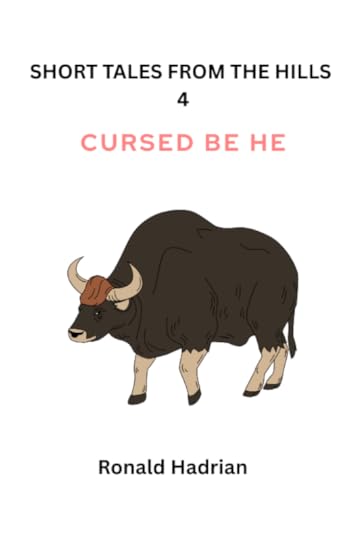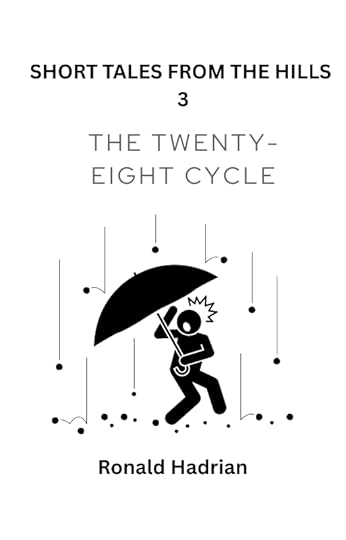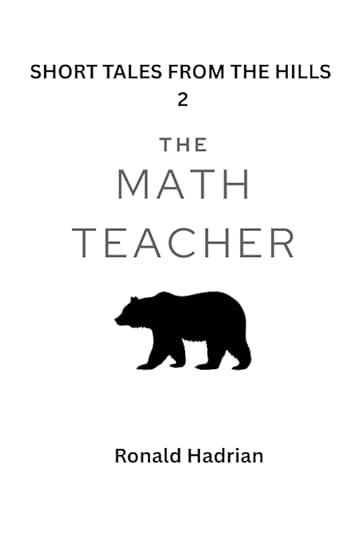Ronald Hadrian's Blog
October 14, 2025
Cursed Be He

Stephen Church Road stretched dark beneath towering trees. Past a small bend, tourists missed the graveyard that locals knew well. Gothic graves bore plain names—Long, Brown, White—but others carried more imagination: Perry, Peter, Wollencroft.
A group of young men claimed the graveyard as their meeting place. They sat on the stones and invented stories about the dead, spinning tales from the names carved above them.
One evening they discussed Mervin Anna Durai and his epitaph borrowed from Shakespeare:
“Blessed be the man who spares these stones, Cursed be he who moves my bones.”
Vandals broke the grave that night. The boys arrived to find it open, the coffin disintegrated, the skull exposed. They fled and never returned.
Fifteen years passed. The men gathered at the graveyard and recalled their old mischief. They laughed and traded stories. Each carried a secret though.
One man broke the silence. “We all know who opened that grave, don’t we? And what happened after.”
They nodded. Another pulled a crumpled newspaper from his pocket. The headline reported a man found dead, his skull crushed by a gaur. Police discovered he had vandalized a grave the night before.
The post Cursed Be He first appeared on Ronald Hadrian.
September 27, 2025
Percentage Calculator
 Budget Calculator
Budget Calculator Smart financial planning made easy
Enter Amount ₹ Calculate Budget Your Budget Breakdown Total Amount ₹0
Calculate Budget Your Budget Breakdown Total Amount ₹0  Budget Categories
Budget Categories  Tithe 10%
Tithe 10%  Home Improvement 7%
Home Improvement 7%  Charity 3%
Charity 3%  Clothing 2%
Clothing 2%  Vacation 3%
Vacation 3%  Savings 5% const categories = [ { name: 'Tithe', percentage: 10, icon: '🙏', class: 'tithe' }, { name: 'Home Improvement', percentage: 7, icon: '🏠', class: 'home' }, { name: 'Charity', percentage: 3, icon: '❤', class: 'charity' }, { name: 'Clothing', percentage: 2, icon: '👕', class: 'clothing' }, { name: 'Vacation', percentage: 3, icon: '✈', class: 'vacation' }, { name: 'Assorted Savings', percentage: 5, icon: '💰', class: 'savings' }, { name: 'Remaining', percentage: 70, icon: '💵', class: 'remaining' } ]; function formatIndianCurrency(amount) { return new Intl.NumberFormat('en-IN').format(amount); } function calculateBudget() { const amountInput = document.getElementById('amountInput'); const amount = parseFloat(amountInput.value); if (!amount || amount <= 0) { alert('Please enter a valid amount'); return; } // Hide tips section and show results document.getElementById('tipsSection').classList.add('hidden'); document.getElementById('resultsCard').classList.remove('hidden'); // Calculate and display results const resultsContainer = document.getElementById('resultsContainer'); const totalAmount = document.getElementById('totalAmount'); resultsContainer.innerHTML = ''; categories.forEach(category => { const categoryAmount = (amount * category.percentage / 100); const categoryElement = document.createElement('div'); categoryElement.className = `category-item ${category.class}`; categoryElement.innerHTML = ` <div class="category-info"> <div class="category-icon">${category.icon}</div> <div class="category-details"> <h4>${category.name}</h4> <p>${category.percentage}% of total</p> </div> </div> <div class="category-amount">₹${formatIndianCurrency(categoryAmount.toFixed(2))}</div> `; resultsContainer.appendChild(categoryElement); }); totalAmount.textContent = `₹${formatIndianCurrency(amount.toFixed(2))}`; } // Allow Enter key to calculate document.getElementById('amountInput').addEventListener('keypress', function(event) { if (event.key === 'Enter') { calculateBudget(); } }); // Reset to tips when input is cleared document.getElementById('amountInput').addEventListener('input', function() { if (!this.value) { document.getElementById('tipsSection').classList.remove('hidden'); document.getElementById('resultsCard').classList.add('hidden'); } });
Savings 5% const categories = [ { name: 'Tithe', percentage: 10, icon: '🙏', class: 'tithe' }, { name: 'Home Improvement', percentage: 7, icon: '🏠', class: 'home' }, { name: 'Charity', percentage: 3, icon: '❤', class: 'charity' }, { name: 'Clothing', percentage: 2, icon: '👕', class: 'clothing' }, { name: 'Vacation', percentage: 3, icon: '✈', class: 'vacation' }, { name: 'Assorted Savings', percentage: 5, icon: '💰', class: 'savings' }, { name: 'Remaining', percentage: 70, icon: '💵', class: 'remaining' } ]; function formatIndianCurrency(amount) { return new Intl.NumberFormat('en-IN').format(amount); } function calculateBudget() { const amountInput = document.getElementById('amountInput'); const amount = parseFloat(amountInput.value); if (!amount || amount <= 0) { alert('Please enter a valid amount'); return; } // Hide tips section and show results document.getElementById('tipsSection').classList.add('hidden'); document.getElementById('resultsCard').classList.remove('hidden'); // Calculate and display results const resultsContainer = document.getElementById('resultsContainer'); const totalAmount = document.getElementById('totalAmount'); resultsContainer.innerHTML = ''; categories.forEach(category => { const categoryAmount = (amount * category.percentage / 100); const categoryElement = document.createElement('div'); categoryElement.className = `category-item ${category.class}`; categoryElement.innerHTML = ` <div class="category-info"> <div class="category-icon">${category.icon}</div> <div class="category-details"> <h4>${category.name}</h4> <p>${category.percentage}% of total</p> </div> </div> <div class="category-amount">₹${formatIndianCurrency(categoryAmount.toFixed(2))}</div> `; resultsContainer.appendChild(categoryElement); }); totalAmount.textContent = `₹${formatIndianCurrency(amount.toFixed(2))}`; } // Allow Enter key to calculate document.getElementById('amountInput').addEventListener('keypress', function(event) { if (event.key === 'Enter') { calculateBudget(); } }); // Reset to tips when input is cleared document.getElementById('amountInput').addEventListener('input', function() { if (!this.value) { document.getElementById('tipsSection').classList.remove('hidden'); document.getElementById('resultsCard').classList.add('hidden'); } }); The post Percentage Calculator first appeared on Ronald Hadrian.
September 22, 2025
The Twenty-Eight Cycle

Rain fell on Mondays. Rain fell on Tuesdays. Rain pelted the town all week, except Friday evening from 3 to 4 p.m. At that hour, rain ceased—hailstones pounded the earth. Pebbles no larger than kidney stones crashed down alongside boulders the size of third-grade children’s heads.
The phenomenon thrust the town into the spotlight. BBC reporters arrived to document it. This was the only time the town was covered in international news. Smartphones didn’t exist then, so no one captured the event. News crews reached the town late, and by the time cameras rolled, the ice had melted into puddles. But every resident had witnessed the bombardment. Evidence scarred the landscape. Windows shattered, barns collapsed, the school bus bore dents.
Townspeople dreaded another assault, but decades passed in silence—until last week. The cycle returned: constant downpours, then precisely from 3 to 4 p.m., hailstones. This time, ice chunks larger than footballs demolished roofs and maimed residents.
An old man who had survived the first storm as a boy met the reporters:
“I am telling you this is exactly what happened twenty-eight years ago,” he pleaded. “I was standing in the school corridor, and I know vividly how the stones fell…”
“But how big were the stones?”
“Tiny stones, not so big…” His eyes glazed.
No one really believed him. But some whispered, “When it happens next time, we would be dead…twenty-eight years is a long time.”
But Ooty’s weather was unpredictable.
After twenty-eight days, by 3 o’clock, a comet crashed on the town. Luckily, the old man who gave the interview was on a health check-up in Coimbatore.
“This is a miracle… or plain coincidence… Many people died in this horrific disaster,” the reporter said to the man.
“No coincidence. I meant to say twenty-eight days, and that is precisely why I went for a check-up.”
“Then why didn’t you warn the others?” barked the reporter.
“Well, I must have warned them, but I don’t remember. I told my son though.”
Just then a man with a long face, brownish hair came forward.
“He’s got amnesia and is not mentally stable. I am sorry for all the mix-up. He doesn’t know what he’s talking about.”
The reporter’s face turned red. “Who are you?”
“I am his son,” he said, pulling him away from the reporters.
When they were away, the son confronted his father.
“Dad, you shouldn’t be saying such things.”
“But it is the truth. In twenty-eight days, another destruction will happen.”
After twenty-eight hours, the reporters were flocking to the man’s house once again.
“In just twenty-eight hours, a snowstorm arrived and killed most of the people.”
“Oh, I meant to say twenty-eight hours…” the old man sighed. “That damned weather never makes up its mind, does it?”
The post The Twenty-Eight Cycle first appeared on Ronald Hadrian.
September 18, 2025
The Math Teacher

My mother examined the report card worried. Mathematics posed a challenge for me. She glanced at me, then at my father, who sat by the window observing the carnations on the front porch.
“We should send him to tuition,” she said.
My father examined the report card and wondered why I was dumb. He launched into his usual commentary. “I excelled in school, and Mathematics was my favorite subject,” he declared.
I stood there, uncertain. My mind drifted to dragons, owls delivering letters, and unicorns.
Kavitha mentioned that her mathematics teacher offered private lessons for struggling students. Kavitha was my aunt, who had avoided school because she feared this same math teacher, but now she eagerly recommended sending me to her. The hypocrisy of it all. The decision was made and I would attend tuition to pass my board examination next year.
On the first day, my mother accompanied me. Nerves consumed me. I feared everything I had heard about this teacher. I stood on the front porch, and my mother grew tense. I wanted to pee but I sensed her anxiety. After a minute, the door opened. A large woman with a peculiar moustache peered at us. Terror overwhelmed me. I wanted to faint. The first day she taught me one problem and sent me home. She was like a smooth spider inviting me to her web of deceit. Well, the next day, I dreaded going but managed to attend. She demonstrated different methods, and I discovered the lessons fascinating. I began improving. No one at school taught this way and so I went regularly.
Gradually I grew comfortable, until one day I rang the doorbell and she didn’t answer. I waited another minute, wondering what had happened, though I remained uncomfortable visiting there. Perhaps she was sleeping, I thought. I waited ten minutes. I examined the front garden and noticed enormous animal footprints. Even a dog couldn’t leave such marks, and even if it was a dog it must be a really huge dog.
I waited, but as I prepared to leave, the door opened and only her voice emerged.
“No tuition today, return in two days.” I assumed she was ill. I felt relieved…no tuition meant I could skip down the hill, singing while I crunched five-rupee turnip chips on my way home.
Two days later, I returned, and her face appeared hairier than usual. I avoided looking at her. That day, however, I got all my answers wrong. She became furious. For a moment, I glimpsed her face in terror. Hair covered her completely, and throughout her body, hair grew rapidly.
“Ma’am,” I muttered.
“What?”
She stood and within a minute transformed into a wild bear( I really didn’t know at that time). “Children who can’t do math don’t deserve to live.”
She growled and chased me. I slipped and fell, and my fingers touched her eyes. Thank God I had eaten those masala-filled turnip chips and forgotten to wipe my hands. The masala burned her eyes, and I managed to escaped. She didn’t dare leave the house.
Two days later, I developed a fever. My mother worried, but my father said, “He does not want to go tuition. When I was young, I climbed hills filled with leopards and panthers. I once heard a bear roamed the forest, and still, I attended school.”
Oh, dear God, if only he knew. That bear was my math teacher.
The post The Math Teacher first appeared on Ronald Hadrian.
September 14, 2025
THE BLACK BOX

Major Vikram of the Madras Regimental Centre woke to pounding on his door at 5:30 AM. He had slept late after indulging with more brandy than necessary. The army commander had visited two days before. The work was strenuous, and so was the indulgence. The work exhausted him; the alcohol numbed him.
Jawan Kishore stood sweating in the doorway.
“Sir,” he stammered.
“What is it?” Vikram snapped.
“The helicopter crashed. The pilot and army commander could not be found…” He looked puzzled.
Vikram stared. “He left two days ago?”
“No, sir. He returned on a classified mission.”
“From Kumba village?”
“Yes, sir.”
Vikram dressed. Officers gathered, theorizing.
“He visited his mistress,” one suggested.
Vikram knew otherwise.
Within an hour, the officers dispersed. “Vikram, the crash site is quarantined. We don’t want this to get out.”
Vikram drove to the village alone. He entered a shack concealing a biochemical laboratory. The chief scientist met him and showed him what was missing.
“He stole NO5. This compound dissolves organic matter in minutes.”
“The missing bodies.”
The scientist nodded.
Vikram telephoned the defense minister.
“Produce a corpse. Close this file.”
“The laboratory, sir?”
“NO5… not stable… Terminate the research.”
Vikram returned to his office with a small black box.
“A souvenir of the research,” he thought.
Two days later, searchers found only the empty container.
The post THE BLACK BOX first appeared on Ronald Hadrian.
September 12, 2025
Client
Approaching a client as a ghostwriter feels like stepping into the dark.You are clueless where to find them.You are scared of saying the wrong thing.You fear no one actually wants your service.But here is the truth.You do not need to chase random people.You only need to find a group that checks three boxes:→ They are already looking for a solution.→ They have a problem worth solving.→ They have the desire and ability to spend money on it.When you focus on that kind of group, everything changes.Conversations become easier.Clients start coming in.And ghostwriting stops being a guessing game.The skill is not just writing.It is learning where to show up.Once you do that, finding clients is simple.
The post Client first appeared on Ronald Hadrian.
September 1, 2025
Archetypes quiz
Please enter your name to begin.
Start QuizPlease enter your name.
Question / Previous Next Submit Quiz Completed!Here’s how you did.
Your Score
%
out of correct
Try Again Review Your Answers const quizData = [ { question: "According to Northrop Frye's theory, what does 'Structural Criticism' focus on?", options: [ "The social and cultural background of the text", "The internal pattern and symbols within the text itself", "The author's personal life and experiences", "The historical timeline of when the text was written" ], answer: "The internal pattern and symbols within the text itself" }, { question: "Carl Jung's concept of the 'collective unconscious' is described as:", options: [ "An author's unique set of memories and symbols", "The hidden meaning an author consciously places in a story", "A personal reservoir of an individual's forgotten experiences", "A shared reservoir of myths and symbols inherited by all humanity" ], answer: "A shared reservoir of myths and symbols inherited by all humanity" }, { question: "In Frye's framework, what does the 'rhythm' of a story represent?", options: [ "The deeper meaning and verbal structure", "The narrative flow and sequence of events over time", "The recurring symbols found across cultures", "The static, spatial pattern of the work" ], answer: "The narrative flow and sequence of events over time" }, { question: "Which of the following pairings is associated with the 'Tragic Vision' of archetypes?", options: [ "Human: Hero", "Animal: Lamb", "Vegetable: Garden", "Mineral: Desert" ], answer: "Mineral: Desert" }, { question: "Frye's theory suggests that all stories are built on a cycle that mirrors nature. Which literary cycle corresponds to the 'Sunset' and 'Autumn' phases?", options: [ "The myth of the hero's birth and creation", "The myth of paradise and sacred marriage", "The myth of the hero's fall, sacrifice, and isolation", "The myth of chaos, floods, and the hero's defeat" ], answer: "The myth of the hero's fall, sacrifice, and isolation" } ]; // DOM Elements const nameContainer = document.getElementById('name-container'); const quizContainer = document.getElementById('quiz-container'); const resultsContainer = document.getElementById('results-container'); const startBtn = document.getElementById('start-btn'); const nameInput = document.getElementById('name'); const nameError = document.getElementById('name-error'); const questionNumberEl = document.getElementById('question-number'); const totalQuestionsEl = document.getElementById('total-questions'); const questionTextEl = document.getElementById('question-text'); const optionsContainerEl = document.getElementById('options-container'); const progressBar = document.getElementById('progress-bar'); const prevBtn = document.getElementById('prev-btn'); const nextBtn = document.getElementById('next-btn'); const submitBtn = document.getElementById('submit-btn'); const resultHeadingEl = document.getElementById('result-heading'); const scoreEl = document.getElementById('score'); const correctCountEl = document.getElementById('correct-count'); const totalCountEl = document.getElementById('total-count'); const answersSummaryEl = document.getElementById('answers-summary'); const restartBtn = document.getElementById('restart-btn'); // State variables let currentQuestionIndex = 0; let userAnswers = new Array(quizData.length).fill(null); let userName = ''; // Event Listeners startBtn.addEventListener('click', startQuiz); nameInput.addEventListener('keyup', (event) => { if(event.key === 'Enter') { startQuiz(); } }); nextBtn.addEventListener('click', nextQuestion); prevBtn.addEventListener('click', prevQuestion); submitBtn.addEventListener('click', showResults); restartBtn.addEventListener('click', restartQuiz); function startQuiz() { userName = nameInput.value.trim(); if (userName) { nameContainer.classList.add('hidden'); quizContainer.classList.remove('hidden'); loadQuestion(); } else { nameError.classList.remove('hidden'); } } function loadQuestion() { const questionData = quizData[currentQuestionIndex]; // Flip animation const quizCard = document.querySelector('.quiz-card'); quizCard.classList.add('flipping'); setTimeout(() => { questionNumberEl.textContent = currentQuestionIndex 1; totalQuestionsEl.textContent = quizData.length; questionTextEl.textContent = questionData.question; optionsContainerEl.innerHTML = ''; questionData.options.forEach((option, index) => { const optionId = `q${currentQuestionIndex}-option${index}`; const isChecked = userAnswers[currentQuestionIndex] === option; const optionElement = document.createElement('label'); optionElement.htmlFor = optionId; optionElement.className = 'block p-4 border border-slate-200 rounded-lg cursor-pointer hover:bg-indigo-50 transition'; optionElement.innerHTML = ` <input type="radio" name="question${currentQuestionIndex}" id="${optionId}" value="${option}" class="custom-radio" ${isChecked ? 'checked' : ''}> <span class="ml-3 text-slate-700">${option}</span> `; optionsContainerEl.appendChild(optionElement); optionElement.querySelector('input').addEventListener('change', (e) => { userAnswers[currentQuestionIndex] = e.target.value; }); }); updateNavigation(); updateProgressBar(); quizCard.classList.remove('flipping'); }, 300); } function updateNavigation() { prevBtn.classList.toggle('hidden', currentQuestionIndex === 0); nextBtn.classList.toggle('hidden', currentQuestionIndex === quizData.length - 1); submitBtn.classList.toggle('hidden', currentQuestionIndex !== quizData.length - 1); } function updateProgressBar() { const progressPercentage = ((currentQuestionIndex 1) / quizData.length) * 100; progressBar.style.width = `${progressPercentage}%`; } function nextQuestion() { if (currentQuestionIndex < quizData.length - 1) { currentQuestionIndex ; loadQuestion(); } } function prevQuestion() { if (currentQuestionIndex > 0) { currentQuestionIndex--; loadQuestion(); } } function showResults() { let correctAnswers = 0; quizData.forEach((question, index) => { if (userAnswers[index] === question.answer) { correctAnswers ; } }); const scorePercentage = Math.round((correctAnswers / quizData.length) * 100); quizContainer.classList.add('hidden'); resultsContainer.classList.remove('hidden'); resultHeadingEl.textContent = `Well done, ${userName}!`; scoreEl.textContent = scorePercentage; correctCountEl.textContent = correctAnswers; totalCountEl.textContent = quizData.length; displayAnswersSummary(); } function displayAnswersSummary() { answersSummaryEl.innerHTML = '<h3 class="text-xl font-bold text-slate-800 text-center">Review Your Answers</h3>'; // Clear previous summary quizData.forEach((question, index) => { const userAnswer = userAnswers[index]; const correctAnswer = question.answer; const isCorrect = userAnswer === correctAnswer; const summaryItem = document.createElement('div'); summaryItem.className = `result-item bg-white p-5 rounded-lg shadow-sm ${isCorrect ? 'correct' : 'incorrect'}`; let userAnswerHtml = ''; if (userAnswer) { userAnswerHtml = `<p class="text-slate-700 text-sm">Your answer: <span class="font-semibold ${isCorrect ? 'text-green-700' : 'text-red-700'}">${userAnswer}</span></p>`; } else { userAnswerHtml = `<p class="text-slate-700 text-sm"><span class="font-semibold text-red-700">You did not answer this question.</span></p>`; } const correctAnswerHtml = !isCorrect ? `<p class="text-slate-700 text-sm mt-1">Correct answer: <span class="font-semibold text-green-700">${correctAnswer}</span></p>` : ''; summaryItem.innerHTML = ` <p class="font-semibold text-slate-800 mb-2">Q${index 1}: ${question.question}</p> ${userAnswerHtml} ${correctAnswerHtml} `; answersSummaryEl.appendChild(summaryItem); }); } function restartQuiz() { currentQuestionIndex = 0; userAnswers.fill(null); userName = ''; nameInput.value = ''; resultsContainer.classList.add('hidden'); nameError.classList.add('hidden'); nameContainer.classList.remove('hidden'); }The post Archetypes quiz first appeared on Ronald Hadrian.
7 types of Ambiguity
Test your knowledge of William Empson’s “Seven Types of Ambiguity”.
Start QuizPlease enter your name to start.
Question 1 1 / 7 Previous Next Submit Well done, User!You have completed the quiz.
Your Score:
0 / 7
Review Your Answers Try Again const quizData = [ { question: "How did William Empson redefine the concept of 'ambiguity' in his work?", options: [ "As a grammatical mistake that makes writing unclear", "As a feature found only in poetry dealing with psychological conflict", "As any verbal nuance that allows for alternative reactions to the same language", "As a simple pun where one word has two meanings" ], correct: 2 }, { question: "Which type of ambiguity occurs when an author is 'discovering his idea in the act of writing,' leading to a 'blurring of the focus'?", options: [ "Second Type: Alternative Meanings Resolved into Unity", "Fourth Type: Complex State of Mind", "Seventh Type: Full Contradiction", "Fifth Type: Fortunate Confusion" ], correct: 3 }, { question: "The example of Milton's line, 'That specious monster, my accomplished snare,' where words like 'specious' and 'accomplished' carry two distinct meanings simultaneously, is used to illustrate which type of ambiguity?", options: [ "The First Type", "The Third Type", "The Sixth Type", "The Second Type" ], correct: 1 }, { question: "According to the document, what is the primary characteristic of the Seventh Type of ambiguity, 'Full Contradiction'?", options: [ "The reader is forced to invent an interpretation to resolve an irrelevant statement", "Two alternative meanings are resolved into a single, rich meaning", "It marks a fundamental division or deep-seated conflict in the author's mind", "A detail is effective in several ways at once without the reader noticing" ], correct: 2 }, { question: "How are Empson's seven types of ambiguity arranged in his book?", options: [ "In order of increasing logical disorder and psychological complexity", "Chronologically, based on the literary period of the examples", "By the frequency of their appearance in English literature", "Randomly, with no discernible order" ], correct: 0 }, { question: "The Fourth Type of ambiguity is described as making clear a 'complicated state of mind in the author.' What kind of feelings does this type typically convey?", options: [ "A simple sense of humor or wit", "A feeling of absolute certainty and clarity", "Painfully mixed feelings that show internal conflict", "A sense of confusion that the reader must resolve" ], correct: 2 }, { question: "What is Empson's overall conclusion about analyzing ambiguity in poetry?", options: [ "It is a 'niggling' and unnecessary exercise that detracts from the poem's beauty", "It is essential for understanding the complex emotions and intellectual depth compacted within the verse", "It proves that most classical poets were simply making mistakes in their writing", "It should only be applied to works that are intentionally contradictory" ], correct: 1 } ]; // State variables let currentQuestion = 0; let score = 0; let userName = ''; const userAnswers = new Array(quizData.length).fill(null); // DOM Elements const startScreen = document.getElementById('start-screen'); const quizScreen = document.getElementById('quiz-screen'); const resultsScreen = document.getElementById('results-screen'); const nameInput = document.getElementById('name'); const nameError = document.getElementById('name-error'); const startBtn = document.getElementById('start-btn'); const questionTitle = document.getElementById('question-title'); const questionCounter = document.getElementById('question-counter'); const questionText = document.getElementById('question-text'); const optionsContainer = document.getElementById('options-container'); const prevBtn = document.getElementById('prev-btn'); const nextBtn = document.getElementById('next-btn'); const submitBtn = document.getElementById('submit-btn'); const resultGreeting = document.getElementById('result-greeting'); const scoreText = document.getElementById('score-text'); const answersReviewContainer = document.getElementById('answers-review-container'); const restartBtn = document.getElementById('restart-btn'); // Functions function startQuiz() { userName = nameInput.value.trim(); if (userName) { startScreen.classList.add('hidden'); quizScreen.classList.remove('hidden'); loadQuestion(); } else { nameError.classList.remove('hidden'); } } function loadQuestion() { const q = quizData[currentQuestion]; questionTitle.innerText = `Question ${currentQuestion + 1}`; questionCounter.innerText = `${currentQuestion + 1} / ${quizData.length}`; questionText.innerText = q.question; optionsContainer.innerHTML = ''; q.options.forEach((option, index) => { const isSelected = userAnswers[currentQuestion] === index; optionsContainer.innerHTML += ` <div class="quiz-option p-4 border-2 border-slate-200 rounded-lg cursor-pointer ${isSelected ? 'selected' : ''}" onclick="selectOption(${index})" > ${option} </div> `; }); updateNavButtons(); } function selectOption(index) { userAnswers[currentQuestion] = index; // Re-load to update styles visually loadQuestion(); } function updateNavButtons() { prevBtn.classList.toggle('hidden', currentQuestion === 0); nextBtn.classList.toggle('hidden', currentQuestion === quizData.length - 1); submitBtn.classList.toggle('hidden', currentQuestion !== quizData.length - 1); } function nextQuestion() { if (currentQuestion < quizData.length - 1) { currentQuestion++; loadQuestion(); } } function prevQuestion() { if (currentQuestion > 0) { currentQuestion--; loadQuestion(); } } function submitQuiz() { score = 0; userAnswers.forEach((answer, index) => { if (answer === quizData[index].correct) { score++; } }); quizScreen.classList.add('hidden'); resultsScreen.classList.remove('hidden'); showResults(); } function showResults() { resultGreeting.innerText = `Well done, ${userName}!`; scoreText.innerText = `${score} / ${quizData.length}`; answersReviewContainer.innerHTML = ''; quizData.forEach((q, index) => { const userAnswerIndex = userAnswers[index]; const isCorrect = userAnswerIndex === q.correct; const statusClass = isCorrect ? 'correct' : 'incorrect'; let reviewHTML = ` <div class="p-4 border-l-4 rounded-r-lg ${statusClass}"> <p class="font-bold mb-2">${index + 1}. ${q.question}</p> `; if (userAnswerIndex !== null) { reviewHTML += `<p class="text-sm text-slate-600"><strong>Your answer:</strong> ${q.options[userAnswerIndex]}</p>`; } else { reviewHTML += `<p class="text-sm text-slate-600"><strong>Your answer:</strong> Not answered</p>`; } if (!isCorrect) { reviewHTML += `<p class="text-sm text-slate-800 mt-1"><strong>Correct answer:</strong> ${q.options[q.correct]}</p>`; } reviewHTML += `</div>`; answersReviewContainer.innerHTML += reviewHTML; }); } function restartQuiz() { // A simple reload is the easiest way to reset the state location.reload(); } // Event Listeners startBtn.addEventListener('click', startQuiz); nameInput.addEventListener('keyup', (event) => { if (event.key === 'Enter') { startQuiz(); } }); prevBtn.addEventListener('click', prevQuestion); nextBtn.addEventListener('click', nextQuestion); submitBtn.addEventListener('click', submitQuiz); restartBtn.addEventListener('click', restartQuiz);The post 7 types of Ambiguity first appeared on Ronald Hadrian.
August 22, 2025
4 meaning Quiz
Please enter your name to begin:
Start Quiz Poetry & Meaning Quiz
1. What was the primary outcome of I.A. Richards’ experiment with 13 anonymous poems at Cambridge University?
A) The students unanimously agreed on the poems’ meanings. B) The students’ interpretations were chaotic and widely varied. C) The students found the task too difficult to complete. D) The students focused solely on the literal meaning of the poems.2. Which of the following is NOT one of the four types of meaning identified by I.A. Richards?
A) Sense B) Feeling C) Ambiguity D) Intention3. According to the document, how is “Sense” defined?
A) The speaker’s emotional attitude toward the subject. B) The speaker’s attitude toward the listener. C) The plain, literal meaning of the words. D) The ultimate goal or effect the speaker is trying to achieve.4. The example, “My soul is a ship in full sail,” is used to illustrate which common mistake in reading poetry?
A) Over-Serious Acceptance B) Literal-Mindedness C) Misinterpreting the Tone D) Ignoring the Intention5. In a political speech, which two types of meaning are typically most prominent?
A) Sense and Tone B) Feeling and Intention C) Sense and Feeling D) Tone and Intention6. The concept of “Tone” refers to the speaker’s attitude towards what?
A) The subject matter B) Themselves C) The listener or audience D) The underlying facts7. Saying “He is a blood sucking parasite” instead of “He is a politician” is a strong example of which type of meaning?
A) Sense B) Feeling C) Tone D) Intention Show My Score! const userInfoDiv = document.getElementById('user-info'); const quizForm = document.getElementById('quiz-form'); const resultsDiv = document.getElementById('results'); const nameInput = document.getElementById('userName'); let currentUserName = ''; function startQuiz() { currentUserName = nameInput.value; if (currentUserName.trim() === "") { alert("Please enter your name!"); return; } userInfoDiv.classList.add('hidden'); quizForm.classList.remove('hidden'); } quizForm.addEventListener('submit', function(event) { event.preventDefault(); // Prevent form from submitting the traditional way const correctAnswers = { q1: 'B', q2: 'C', q3: 'C', q4: 'B', q5: 'B', q6: 'C', q7: 'B' }; let score = 0; const totalQuestions = Object.keys(correctAnswers).length; for (const question in correctAnswers) { const selectedOption = document.querySelector(`input[name="${question}"]:checked`); if (selectedOption && selectedOption.value === correctAnswers[question]) { score++; } } // Hide the quiz and show the results quizForm.classList.add('hidden'); resultsDiv.classList.remove('hidden'); let resultMessage = `<h2>Quiz Results</h2>`; resultMessage += `<p>Well done, ${currentUserName}!</p>`; resultMessage += `<p>You scored ${score} out of ${totalQuestions}.</p>`; if (score === totalQuestions) { resultMessage += `<p>🎉 Perfect score! You're an expert! 🎉</p>`; } else if (score >= totalQuestions / 2) { resultMessage += `<p>👍 Great job! You know your stuff. 👍</p>`; } else { resultMessage += `<p>🤔 Good try! Keep learning. 🤔</p>`; } resultsDiv.innerHTML = resultMessage; });The post 4 meaning Quiz first appeared on Ronald Hadrian.
August 18, 2025
Metaphyical Poetry quiz
Test your knowledge on the 17th-century literary movement.
Enter your name to begin: Start Quiz Good luck! Submit Answers Quiz Results Take Again const nameSection = document.getElementById('name-section'); const quizSection = document.getElementById('quiz-section'); const resultsSection = document.getElementById('results-section'); const startBtn = document.getElementById('start-btn'); const usernameInput = document.getElementById('username'); const quizHeader = document.getElementById('quiz-header'); const quizForm = document.getElementById('quiz-form'); const questionsContainer = document.getElementById('questions-container'); const resultHeader = document.getElementById('result-header'); const scoreEl = document.getElementById('score'); const correctAnswersEl = document.getElementById('correct-answers'); const restartBtn = document.getElementById('restart-btn'); // --- Quiz Questions --- // Based on the provided PDF "The Metaphysical Poets.pdf" const quizData = [ { question: "Who first used the term 'metaphysical poets'?", options: ["T.S. Eliot", "John Dryden", "Samuel Johnson", "John Donne"], answer: "John Dryden" }, { question: "Which 18th-century critic famously said the Metaphysical poets' ideas were 'yoked by violence together'?", options: ["Alexander Pope", "William Wordsworth", "Dr. Samuel Johnson", "H.J.C. Grierson"], answer: "Dr. Samuel Johnson" }, { question: "Which 20th-century poet and critic was instrumental in reviving the reputation of the Metaphysical poets with his 1921 essay?", options: ["W.B. Yeats", "Ezra Pound", "T.S. Eliot", "George Herbert"], answer: "T.S. Eliot" }, { question: "What term did T.S. Eliot coin to describe a split between thought and feeling in poetry?", options: ["Unified Sensibility", "Objective Correlative", "Negative Capability", "Dissociation of Sensibility"], answer: "Dissociation of Sensibility" }, { question: "Who is considered the leading and most canonical figure among the Metaphysical poets?", options: ["Andrew Marvell", "George Herbert", "John Donne", "Henry Vaughan"], answer: "John Donne" }, { question: "What is a 'conceit' in the context of Metaphysical poetry?", options: ["A simple rhyme scheme", "A short, lyrical poem", "A startling, far-fetched comparison between two very different things", "A type of conversational tone"], answer: "A startling, far-fetched comparison between two very different things" }, { question: "According to T.S. Eliot's argument, what is a necessary quality for modern poetry?", options: ["Simplicity", "Complexity", "Romanticism", "Sentimentality"], answer: "Complexity" } ]; let currentUsername = ''; // --- Event Listeners --- startBtn.addEventListener('click', startQuiz); quizForm.addEventListener('submit', showResults); restartBtn.addEventListener('click', restartQuiz); // --- Functions --- /** * Starts the quiz after the user enters their name. */ function startQuiz() { currentUsername = usernameInput.value.trim(); if (currentUsername === "") { // Simple validation: prompt user if name is empty alert("Please enter your name to start the quiz."); return; } quizHeader.textContent = `Good luck, ${currentUsername}!`; nameSection.classList.add('hidden'); resultsSection.classList.add('hidden'); quizSection.classList.remove('hidden'); loadQuestions(); } /** * Loads and displays the quiz questions. */ function loadQuestions() { questionsContainer.innerHTML = ''; // Clear previous questions quizData.forEach((q, index) => { const questionEl = document.createElement('div'); questionEl.classList.add('mb-6', 'p-4', 'border', 'border-gray-200', 'rounded-lg'); let optionsHTML = ''; q.options.forEach(option => { optionsHTML += ` <label class="flex items-center p-3 rounded-lg hover:bg-gray-50 transition cursor-pointer"> <input type="radio" name="question${index}" value="${option}" class="h-4 w-4 custom-radio text-blue-600 border-gray-300 focus:ring-blue-500"> <span class="ml-3 text-gray-700">${option}</span> </label> `; }); questionEl.innerHTML = ` <p class="text-lg font-semibold text-gray-800 mb-3">${index + 1}. ${q.question}</p> <div class="space-y-2">${optionsHTML}</div> `; questionsContainer.appendChild(questionEl); }); } /** * Calculates score and displays the results section. * @param {Event} e - The form submission event. */ function showResults(e) { e.preventDefault(); let score = 0; const userAnswers = []; // Collect user answers quizData.forEach((q, index) => { const selectedOption = document.querySelector(`input[name="question${index}"]:checked`); const userAnswer = selectedOption ? selectedOption.value : null; userAnswers.push(userAnswer); if (userAnswer === q.answer) { score++; } }); // Display results quizSection.classList.add('hidden'); resultsSection.classList.remove('hidden'); resultHeader.textContent = `Well done, ${currentUsername}!`; scoreEl.textContent = `You scored ${score} out of ${quizData.length}.`; correctAnswersEl.innerHTML = ''; quizData.forEach((q, index) => { const userAnswer = userAnswers[index]; const isCorrect = userAnswer === q.answer; const resultEl = document.createElement('div'); resultEl.classList.add('p-4', 'rounded-lg', 'border'); resultEl.classList.add(isCorrect ? 'bg-green-50 border-green-200' : 'bg-red-50 border-red-200'); let answerHTML = `<p class="text-sm font-semibold text-green-700">Correct Answer: ${q.answer}</p>`; if (!isCorrect) { answerHTML += `<p class="text-sm font-semibold text-red-700">Your Answer: ${userAnswer || 'Not answered'}</p>`; } resultEl.innerHTML = ` <p class="font-semibold text-gray-800 mb-2">${index + 1}. ${q.question}</p> ${answerHTML} `; correctAnswersEl.appendChild(resultEl); }); } /** * Resets the quiz to the initial name entry screen. */ function restartQuiz() { resultsSection.classList.add('hidden'); nameSection.classList.remove('hidden'); usernameInput.value = ''; // Clear the name input quizForm.reset(); // Reset the form selections }The post Metaphyical Poetry quiz first appeared on Ronald Hadrian.



